Featured wildlife 1
Portal:Tanzania/Featured wildlife/1

The Olive Baboon (Papio anubis), also called the Anubis Baboon, is a member of the family Cercopithecidae (Old World monkeys). The species is the most widely spread of all baboons: it is found in 25 countries throughout Africa, extending south from Mali to Ethiopia and to Tanzania. Isolated populations are also found in some mountainous regions of the Sahara. It inhabits savannahs, steppes, and forest areas.
Featured wildlife 2
Portal:Tanzania/Featured wildlife/2

The Black Rhinoceros or Hook-lipped Rhinoceros (Diceros bicornis), is a species of rhinoceros, native to the eastern and central areas of Africa including Kenya, Tanzania, Cameroon, South Africa, Namibia, Zimbabwe, and Angola. Although the Rhino is referred to as black, it is actually more of a grey/brown/white color in appearance. The name of the species was chosen to distinguish it from the White Rhinoceros (Ceratotherium simum).
Featured wildlife 3
Portal:Tanzania/Featured wildlife/3
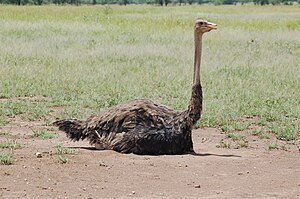
The Ostrich, Struthio camelus, is a large flightless bird native to Africa. It is the only living species of its family and its genus. Ostriches share the order Struthioniformes with the kiwis, Emus, and other ratites. It is distinctive in its appearance, with a long neck and legs and the ability to run at maximum speeds of about 70 km/h (45 mph), the top land speed of any bird.
Featured wildlife 4
Portal:Tanzania/Featured wildlife/4

The giraffe (Giraffa camelopardalis) is an African even-toed ungulate mammal, the tallest of all land-living animal species, and the largest ruminant. It is covered in large, irregular patches of yellow to black fur separated by white, off-white, or dark yellowish brown background. The average mass for an adult male giraffe is 1,200 kilograms (2,600 lb) while the average mass for an adult female is 830 kilograms (1,830 lb).
Featured wildlife 5
Portal:Tanzania/Featured wildlife/5
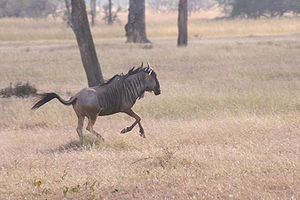
The Blue Wildebeest (Connochaetes taurinus), also called the Common Wildebeest and the Brindled Gnu, is a large antelope and one of two species of wildebeest. It grows to 1.7 m shoulder height and attains a body mass of up to 380 kg. They range the open plains, bushveld and dry woodlands of Southern and East Africa, realizing a life span in excess of twenty years.
Featured wildlife 6
Portal:Tanzania/Featured wildlife/6

The Aldabra Giant Tortoise (Geochelone gigantea), from the islands of the Aldabra Atoll in the Seychelles, is one of the largest tortoises in the world. This species is widely referred to as Geochelone gigantea but is now placed in the genus Dipsochelys (or sometimes in the invalid genus Aldabrachelys) as Dipsochelys dussumieri. A small isolated population of the species resides on the island of Zanzibar.
Featured wildlife 7
Portal:Tanzania/Featured wildlife/7

The African Bush Elephant (Loxodonta africana) is the larger of the two species of African elephant. Both it and the African Forest Elephant have usually been classified as a single species, known simply as the African Elephant. Some authorities still consider the currently available evidence insufficient for splitting the African Elephant into two species. It is also known as the Bush Elephant or Savanna Elephant.
Featured wildlife 8
Portal:Tanzania/Featured wildlife/8
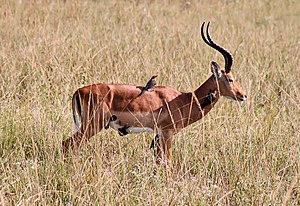
An impala (Aepyceros melampus Greek αιπος, aipos "high" κερος, ceros "horn" + melas "black" pous "foot") is a medium-sized African antelope. The name impala comes from the Zulu language meaning "Gazelle". They are found in savannas and thick bushveld in Kenya, Tanzania, Eswatini, Mozambique, northern Namibia, Botswana, Zambia, Zimbabwe, southern Angola, northeastern South Africa and Uganda.
Featured wildlife 9
Portal:Tanzania/Featured wildlife/9

The lion (Panthera leo) is one of the four big cats in the genus Panthera, and a member of the family Felidae. With some males exceeding 250 kg (550 lb) in weight, it is the second-largest living cat after the tiger. Wild lions currently exist in Sub-Saharan Africa and in Asia with a critically endangered remnant population in Gir Forest National Park in India.
Featured wildlife 10
Portal:Tanzania/Featured wildlife/10
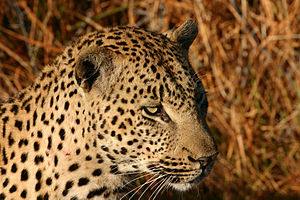
The leopard /ˈlɛpərd/, Panthera pardus, is a member of the Felidae family and the smallest of the four "big cats" in the genus Panthera, the other three being the tiger, lion and jaguar. Once distributed across eastern and southern Asia and Africa, from Siberia to South Africa, the leopard's range of distribution has decreased radically because of hunting and loss of habitat.
Featured wildlife 11
Portal:Tanzania/Featured wildlife/11
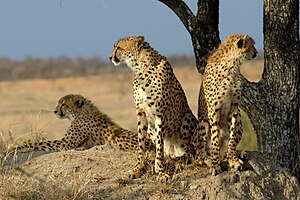
The cheetah (Acinonyx jubatus) is an atypical member of the cat family (Felidae) that is unique in its speed, while lacking climbing abilities. The species is the only living member of the genus Acinonyx. It is the fastest land animal, reaching speeds between 112 and 120 km/h (70 and 75 mph) in short bursts covering distances up to 460 m (1,510 ft).
Featured wildlife 12
Portal:Tanzania/Featured wildlife/12
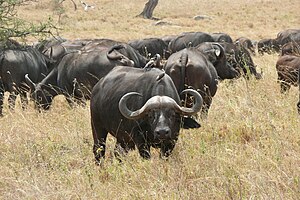
The African buffalo, affalo or cape buffalo (Syncerus caffer) is a large African bovid. It is not closely related to the slightly larger wild Asian water buffalo, but its ancestry remains unclear. Owing to its unpredictable nature which makes it highly dangerous to humans, it has not been domesticated, unlike its Asian counterpart, the domestic Asian water buffalo.
Featured wildlife 13
Portal:Tanzania/Featured wildlife/13

The White Rhinoceros or Square-lipped rhinoceros (Ceratotherium simum) is one of the five species of rhinoceros that still exist and is one of the few megafaunal species left. It has a wide mouth used for grazing and is the most social of all rhino species. The White Rhino consists of two subspecies: the Southern White Rhino and the much rarer Northern White Rhino.
Featured wildlife 14
Portal:Tanzania/Featured wildlife/14

The African Wild Dog is a medium-sized canid found only in Africa, especially in savannas and other lightly wooded areas. It is also called the Painted Hunting Dog, African Hunting Dog, the Cape Hunting Dog, the Spotted Dog, or the Painted Wolf in English, Wildehond in Afrikaans, and Mbwa mwitu in Swahili. It is the only species in the genus Lycaon.
Featured wildlife 15
Portal:Tanzania/Featured wildlife/15
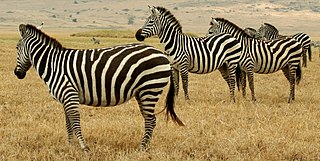
Zebras are African equids best known for their distinctive white and black stripes. Their stripes come in different patterns unique to each individual. They are generally social animals and can be seen in small harems to large herds. In addition to their stripes, zebras have erect, mohawk-like manes. Unlike their closest relatives, horses and asses, zebras have never been truly domesticated.
Featured wildlife 16
Portal:Tanzania/Featured wildlife/16

The serval, Leptailurus serval, is a medium-sized African wild cat. Modern molecular DNA analysis indicates servals descend from the same Felid ancestor as the lion. The serval maintains its own unique lineage, and appears to share common traits with the cheetah, which may have descended from ancient servals. Similar DNA studies have shown the African golden cat and the caracal are closely related to the serval.
Featured wildlife 17
Portal:Tanzania/Featured wildlife/17
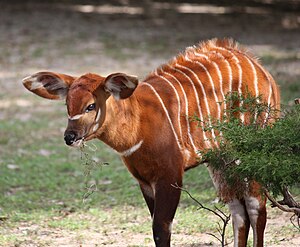
The western or lowland bongo, Tragelaphus eurycerus eurycerus, is a herbivorous, mostly nocturnal forest ungulate and among the largest of the African forest antelope species. Bongos have a reddish-brown coat, black and white markings, white-yellow stripes and long slightly spiralled horns. Indeed, bongos are the only Tragelaphid in which both sexes have horns. Bongos have a complex social interaction and are found in African dense forest mosaics.
Featured wildlife 18
Portal:Tanzania/Featured wildlife/18

The Warthog or Common Warthog (Phacochoerus africanus) is a wild member of the pig family that lives in Africa. The common name comes from the four large wart-like protrusions found on the head of the warthog, which serve the purpose of defence when males fight. They are the only widely recognised species in their genus, though some authors divide them into two species.
Featured wildlife 19
Portal:Tanzania/Featured wildlife/19
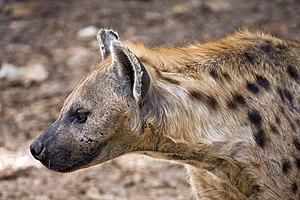
The Spotted Hyena (Crocuta crocuta) also known as Laughing Hyena, is a carnivorous mammal of the family Hyaenidae, of which it is the largest extant member. Though the species' prehistoric range included Eurasia extending from Atlantic Europe to China, it now only occurs in all of Africa south of the Sahara save for the Congo Basin. Spotted hyenas live in large matriarchal communities called clans.
Featured wildlife 20
Portal:Tanzania/Featured wildlife/20
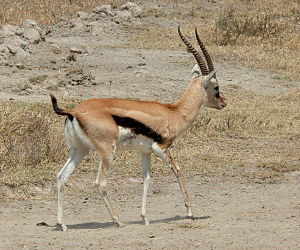
The Thomson's gazelle (Eudorcas thomsonii) is one of the best-known gazelles. It is named after explorer Joseph Thomson and, as a result, is sometimes referred to as a "tommie". It is considered by some to be a subspecies of the Red-fronted Gazelle and was formerly considered a member of the genus Gazella within the subgenus Eudorcas, before Eudorcas was elevated to genus status.
Featured wildlife 21
Portal:Tanzania/Featured wildlife/21

The hippopotamus (Hippopotamus amphibius), from the ancient Greek for "river horse", is a large, mostly herbivorous mammal in sub-Saharan Africa, and one of only two extant species in the family Hippopotamidae (the other is the Pygmy Hippopotamus.) The hippopotamus is the second largest land animal (after the elephant) and the heaviest extant artiodactyl, despite being considerably shorter than the giraffe.
Nominations
Please place candidates in the section below ("New nominations") for future selected wildlifes, using the following template:
=== [[:File:Your subject here|Your subject here]] === [[File:Your image here|300px|Image description here.]] <small>Credit: ''Who took the photograph?''</small><br /> Include a summary or the first paragraph of the subject's article here. ---- Include your reasons for nominating the selecetd wildlife here. ~~~~ <br clear="all">